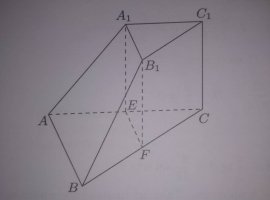I attached the photo of the frustum given in the problem.
Since the bases are similar triangles, and the problem specifies that the ratio of appropriate sides of the bases is 1/2, solution says the following equation holds:
[math]B/B_1 = AB^2/A_1B_1^2 => B/B_1 = 2^2 / 1^2[/math]
I don't understand how this can be if area of a triangle can only be expressed ( in general case ) with one side and its adequate altitude ( unless we can incorporate a larger number of variables such as with using Hero's formula, or if we have radii of the inscribed or circumscribed circles ). Thus, I see no justification for the exponentiation of the sides AB and A_1B_1.
To my mind, the only mathematically justified way to write the equation using ratios would be:
[math]B/B_1 = AB*h_A / A_1B_1*h_a[/math]
But this is useless, since we have no ratio between appropriate heights of any two sides given in the problem.
I didn't give the whole formulation of the problem because this fraction was the only one I had any trouble with.
I would immensely appreciate any help.
Since the bases are similar triangles, and the problem specifies that the ratio of appropriate sides of the bases is 1/2, solution says the following equation holds:
[math]B/B_1 = AB^2/A_1B_1^2 => B/B_1 = 2^2 / 1^2[/math]
I don't understand how this can be if area of a triangle can only be expressed ( in general case ) with one side and its adequate altitude ( unless we can incorporate a larger number of variables such as with using Hero's formula, or if we have radii of the inscribed or circumscribed circles ). Thus, I see no justification for the exponentiation of the sides AB and A_1B_1.
To my mind, the only mathematically justified way to write the equation using ratios would be:
[math]B/B_1 = AB*h_A / A_1B_1*h_a[/math]
But this is useless, since we have no ratio between appropriate heights of any two sides given in the problem.
I didn't give the whole formulation of the problem because this fraction was the only one I had any trouble with.
I would immensely appreciate any help.

